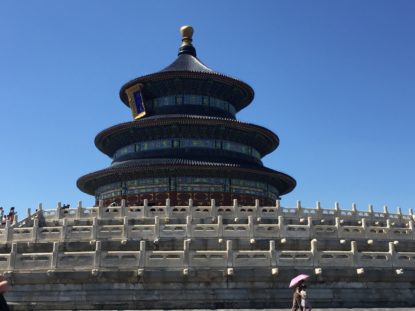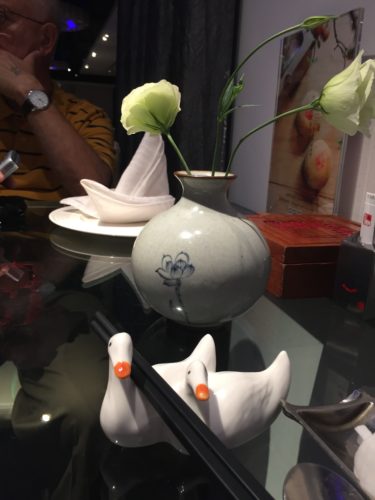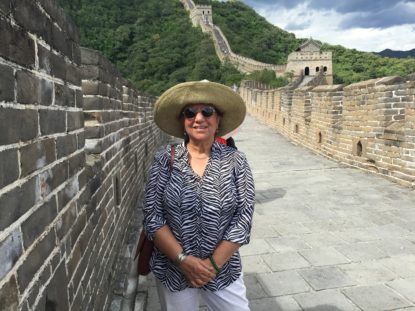
Three Nights in Beijing
Two scholars who introduced me to the deeply stirring Chinese philosophy and its inspiring landscape painting were professor Wing-Tsit Chan (Chatham College now Chatham University) and professor Katheryn M. Linduff (University of Pittsburgh), respectively. What they taught me resurfaced from the depths as I travelled in China.
Treading the yellow earth I wanted to feel the essence of Lao Tzu’s teachings: “Do the difficult things while they are easy and do the great things while they are small. A journey of a thousand miles must begin with a single step.”
I wanted to witness Confucian teachings about order, harmony and wisdom. “By three methods we may learn wisdom: by reflection which is noblest; by imitation which is easiest; and by experience which is bitterest.” And Chuang Tzu, “Happiness is the absence of the striving for happiness.”
I wanted to experience Chan Buddhism that the first Indian patriarch, Bodhidharma transmitted in China. “The ignorant mind, with its infinite afflictions, passions, and evils, is rooted in anger, craving and delusion.”
My professors had prepared me intellectually and academically for China but I was in search for it’s heart. I understand one cannot experience ethos of a culture in two weeks but by the end of our trip I was able to touch the heart of China by virtue of conversations with its people and by sharing meals with them.
Beijing was our first stop. At every airport an English speaking guide, and a driver who did not speak English, met us. Beijing has been the northern capital of China for the last eight centuries. Driving from the airport to the center of the modern metropolis, it could have been New York or New Delhi but for the signs in Chinese characters and Chinese people. However, the profusion of high-rise buildings gave it a feeling of a concrete jungle. The guide said the capital has been growing skywards since 2000.
We took a nap and went for a walk on the pedestrian street and returned to the hotel for dinner.
Next day we visited Chairman Mao’s Mausoleum and walked to Tiananmen Square. Chairman Mao’s portrait overlooked a vast open arena. The Chinese characters flanking the picture on the left said “Long Life to the People’s Republic of China” and on the right, “Long Life for the Great unity of the whole world.” Hall of the People was on our left of the square. Other important government buildings and museums were also visible on the left and right of the square. The whole view was dotted with bright red and yellow colors, on national flags, on flowerbeds and blossoms, on the signs.
Behind the well-known wall, with Mao’s portrait, was the entrance to the Forbidden City the palace of the last emperor. The complex was the Chinese imperial palace from the Ming Dynasty to the end of the Quig dynasty (1420-1912). A moat surrounds the palace.
Our next stop was Temple of Heaven; a religious building used by emperors of the Ming and Quig dynasties only for annual ceremonies. Here they prayed to Heaven for good harvest and security. The rooftops of the palace and the temple were red or yellow as were the decorations that glittered under the sunlight. The yellow/gold color is considered to be imperial color and red to be auspicious.
We sauntered through the imperial palace, its museum and the Temple stopping to look, to admire, to marvel, and take pleasure in the indigenous styles, materials and ambiance. Foreign dignitaries visiting Chinese emperors brought them gifts including watches. They were accepted gracefully but hidden because a clock or a watch is bad luck in China, symbols of longevity such as crane is good luck.
“Chinese are not religious but very superstitious,” Yan Jia said. She said if her name was hard to remember we could call her Rainbow. A petite young woman with a chubby face and quick warm smile she was stylish, confident and knowledgeable.
She drove us to Mein Chou where we had our first authentic Chinese meal. Shrimps with cashew, Gailan greens, peanuts with chilies, beef with mushrooms, corn and rice.
After a several hours of deep sleep we went to a Peking duck restaurant. The duck was served with two kinds of pancakes, mustard greens and accompaniments.
Our last day was spent at the Great Wall of China, long and monumental that it is visible from the space. Being in its proximity was like being in touch with history. The surrounding landscape was spectacular. A chairlift carried us to the watchtower 6 from where we walked to the watchtower 14, more than three miles walk up and down the stone path. Walking between two parapets, viewing the undulating mountain peaks and trees under the sunlight in 90 degree took a toll on us.
Yan Jia had arranged a mouth-watering lunch of rainbow trout, broccoli with garlic chicken with chestnuts, pork ribs to die for, egg fried rice and noodles. There was variety of meats though in small quantities.
“Chinese eat everything with legs, except the table,” Yan Jai commented.
As a rule drivers and guides are not supposed to eat with their clients. But we insisted that they sit with us. We wanted to know about the food and about their culture and people. Some reluctantly some with just one invitation eventually did join us. They remained a bit distant for the first few hours but opened up after we shared a meal.
Yan Jia said her grandparents liked what Chairman Mao had done to the country. They were all so wretchedly poor when the emperor ruled. The younger generation calls the Cultural Revolution as Mao’s mistake. Yan Jia did not have any sibling as her generation was from, one family, one-child law years. As families performed female infanticide the ratio of women to men was low. So much so that now men have to give dowry to women’s family. Women demand four Cs in a man: Condo, cash, car and cute (boy).

































Virni Agarwal
The piece was so pretty involving and captivating I felt like a part of it.
The pictures are beautiful and the food mouthwatering !
Madhu B. Wangu
So glad you enjoyed the post, Virni! Thank you for your comment!